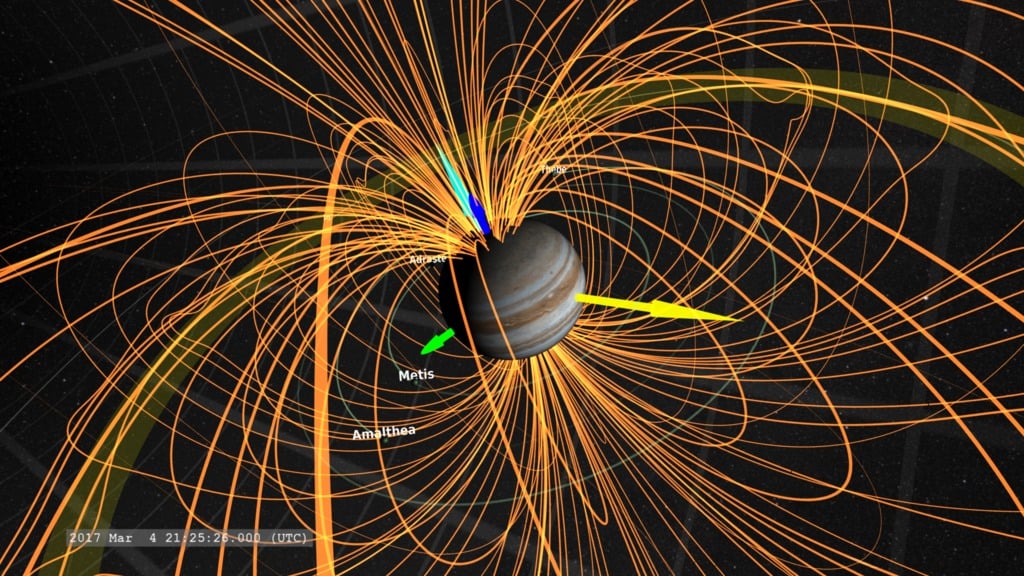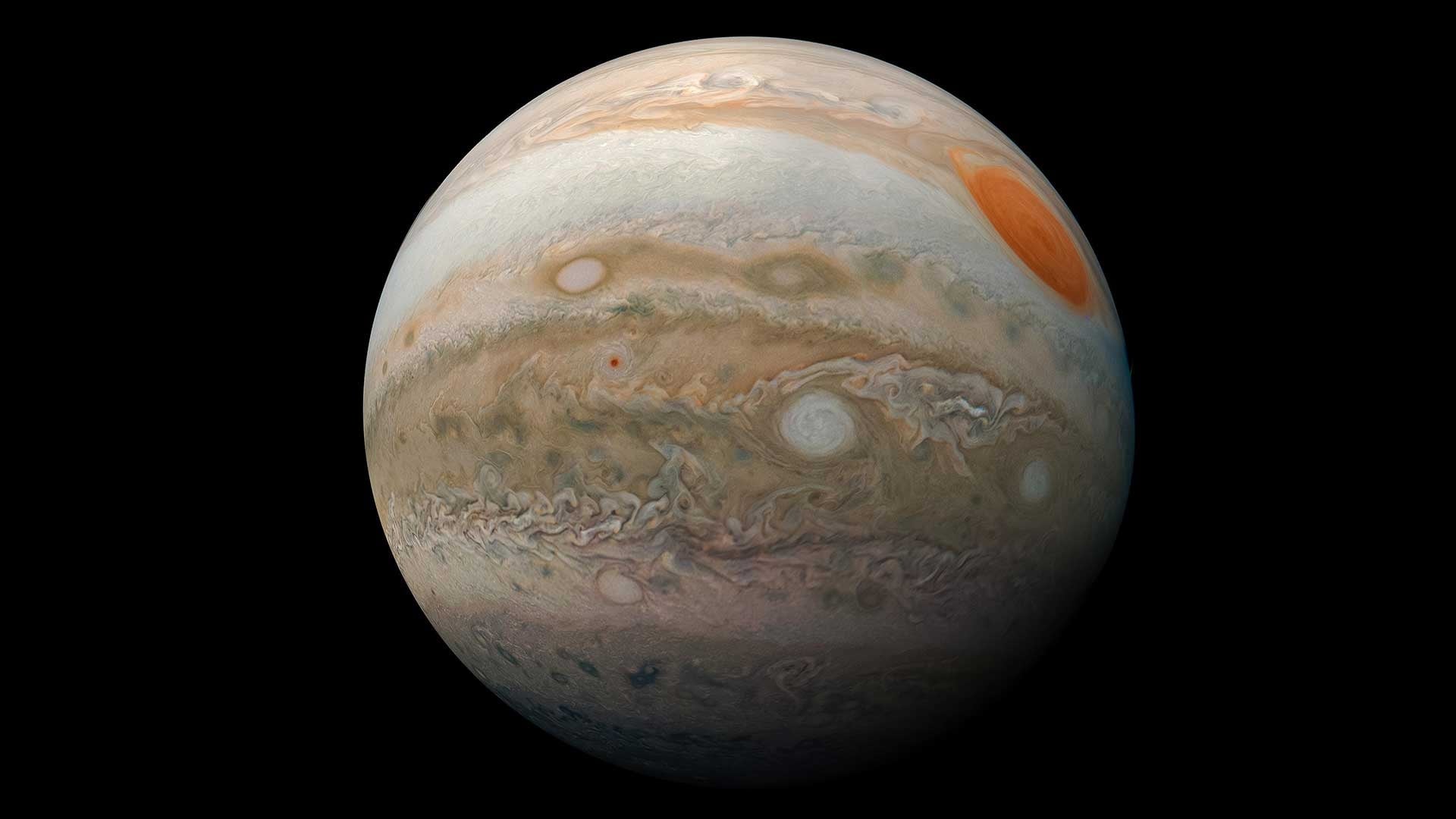The planet Jupiter has played a vital role in the evolution of the Solar System, according to our current models. On the one hand, its formation (ca. 4.6 billion years ago) and powerful gravity are thought to have played a critical role in shaping the orbital paths of the other Solar planets, sculpting the disk of gas and dust from which they formed, and influencing the distribution of planetesimals and the formation of the Main Asteroid Belt. Scientists have also theorized that Jupiter played a role in the emergence of life by absorbing asteroids that could have impacted Earth.
Understanding the formation history of Jupiter is therefore vital to understanding how the early Solar System evolved. In a recent paper, astronomers Konstantin Batygin and Fred C. Adams conducted a detailed study of Jupiter's primordial state. Their results indicate that 3.8 billion after the Solar System after the first solids formed in the Solar System's protoplanetary nebula, Jupiter was 2 to 2.5 times as large as it is today. They also determined that it possessed a magnetic field 50 times more powerful than it has today.
Whereas Batygin is a professor of planetary science and astrophysics at the California Institute of Technology(Caltech), Fred C. Adams is the Ta-You Wu Collegiate Professor of Physics and Director of the Leinweber Center for Theoretical Physics(U-M LSA) at the University of Michigan. The paper describing their findings, "Determination of Jupiter's primordial physical state," recently appeared on May 20th, 2025, in the journal*Nature Astronomy*.
 In celestial mechanics, the traditional paradigm where the evolution of the Solar System was attributed solely to the influence of Jupiter and the Sun is deeply rooted. However, observations have increasingly highlighted the importance of Jupiter in sculpting the Solar System's architecture. As such, the full history of Jupiter's origins and structural evolution is viewed as a key milestone in the early evolution of the Solar System. However, the details and timing of Jupiter's formation remain elusive largely because of the inherent uncertainties of accretionary models.
In celestial mechanics, the traditional paradigm where the evolution of the Solar System was attributed solely to the influence of Jupiter and the Sun is deeply rooted. However, observations have increasingly highlighted the importance of Jupiter in sculpting the Solar System's architecture. As such, the full history of Jupiter's origins and structural evolution is viewed as a key milestone in the early evolution of the Solar System. However, the details and timing of Jupiter's formation remain elusive largely because of the inherent uncertainties of accretionary models.
For their study, Batygin and Adams examined Amalthea and Thebe, two of Jupiter's inner satellites. This family of satellites is low-mass and orbits even closer to Jupiter than Io, the smallest and closest-orbiting of Jupiter's Galilean Moons. Both of these satellites have slightly tilted orbits and small orbital discrepancies, which allowed Batygin and Adams to calculate Jupiter's original size. According to their results, Jupiter once had a volume of more than 2,000 Earths, roughly twice its current volume of 1,321 Earths. As Batygin said in a Caltech news story:
Our ultimate goal is to understand where we come from, and pinning down the early phases of planet formation is essential to solving the puzzle. This brings us closer to understanding how not only Jupiter but the entire solar system took shape. What we've established here is a valuable benchmark. A point from which we can more confidently reconstruct the evolution of our solar system.
These insights are especially significant because they bypass traditional uncertainties in planetary formation models. These often rely on assumptions concerning the ability of a gas to absorb or scatter electromagnetic radiation, rates of accretion, and the mass of Jupiter's core (composed of rock and metal). Instead, the team focused on directly measurable quantities, including the conservation of Jupiter's angular momentum and the orbital dynamics of its moons.
 Batygin and Adams' analysis provides a crucial picture of one of Jupiter's critical development stages, which has been subject to uncertainty in the past. In essence, it provides insight into the period when the solar nebula from which the planets formed evaporated. This was a critical transition point when the building blocks of the planets disappeared and the primordial architecture of the Solar System emerged. "It's astonishing that even after 4.5 billion years, enough clues remain to let us reconstruct Jupiter's physical state at the dawn of its existence," said Adams.
Batygin and Adams' analysis provides a crucial picture of one of Jupiter's critical development stages, which has been subject to uncertainty in the past. In essence, it provides insight into the period when the solar nebula from which the planets formed evaporated. This was a critical transition point when the building blocks of the planets disappeared and the primordial architecture of the Solar System emerged. "It's astonishing that even after 4.5 billion years, enough clues remain to let us reconstruct Jupiter's physical state at the dawn of its existence," said Adams.
These results could also add new insight into theories about planet formation, which could have implications for exoplanet studies. These theories suggest that Jupiter and the gas giants formed as rocky and icy material (which formed the core of these planets) rapidly accreted gas from the solar nebula. This new study builds on traditional models by providing more exact measurements of Jupiter's size, spin rate, and magnetic conditions when it was still in a primordial state.
Their research was funded by Caltech, the David and Lucile Packard Foundation, the National Science Foundation (NSF), the University of Michigan, and the Leinweber Center for Theoretical Physics.
 Universe Today
Universe Today
